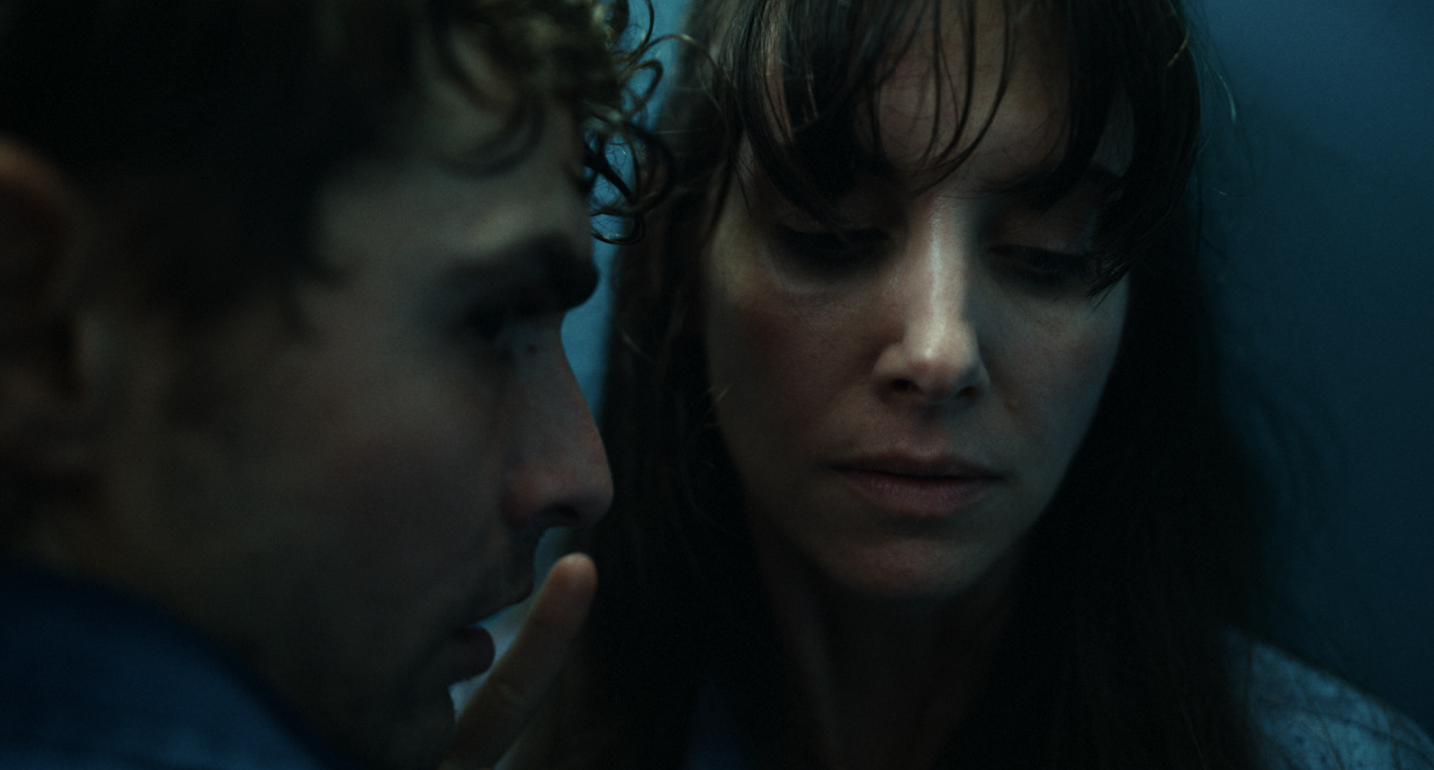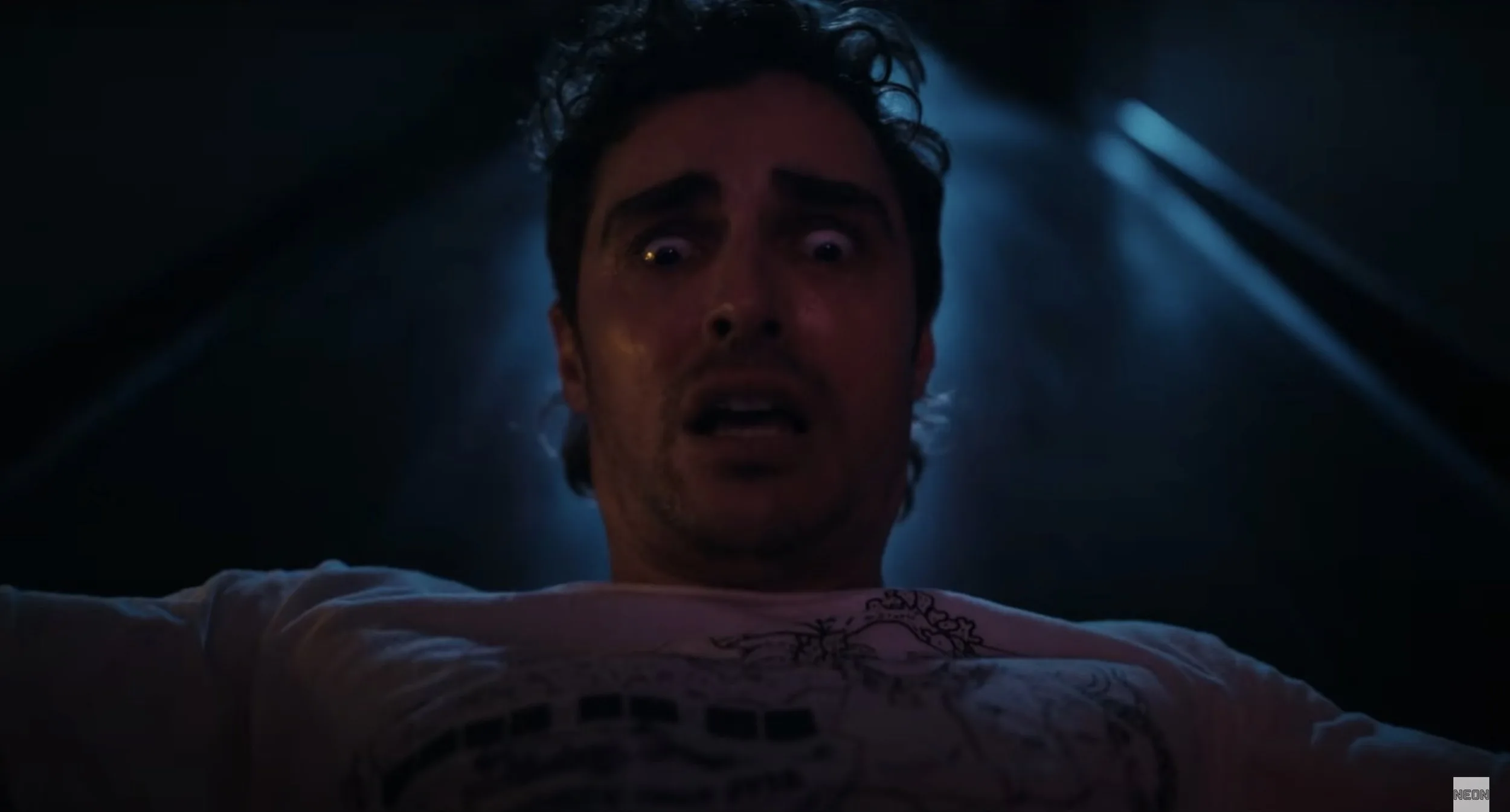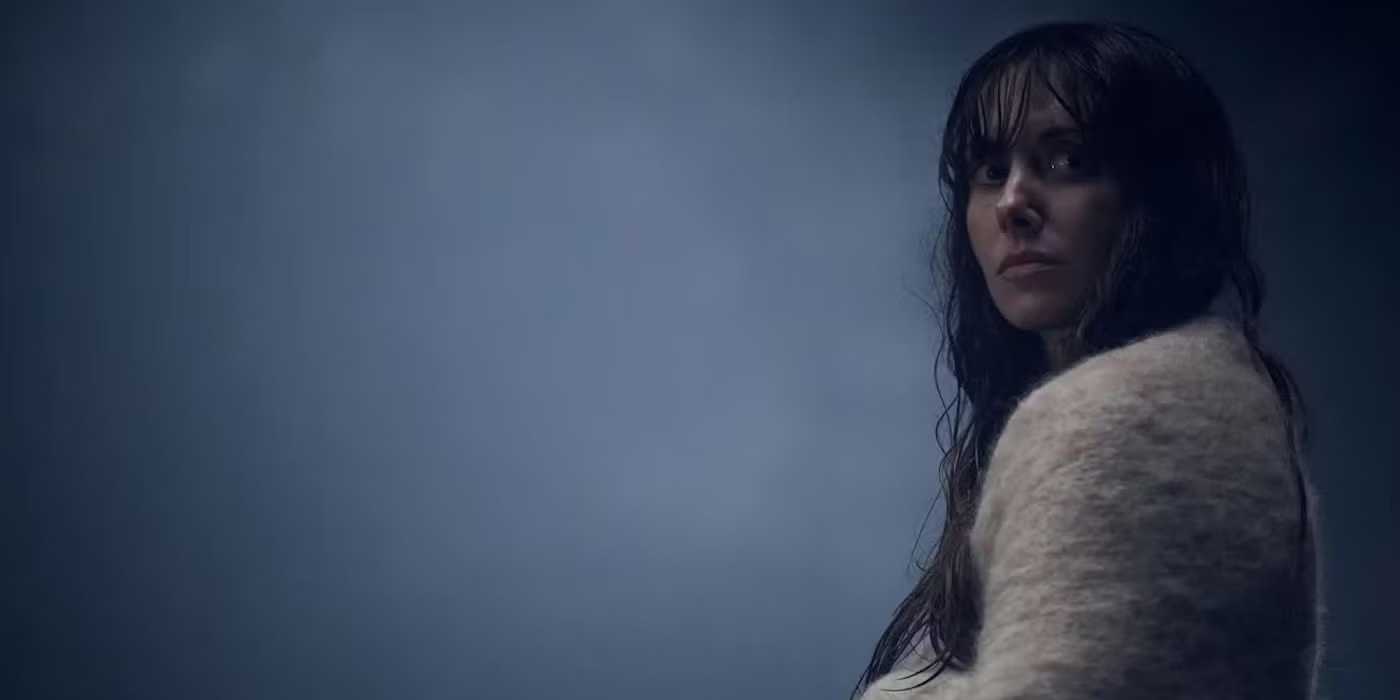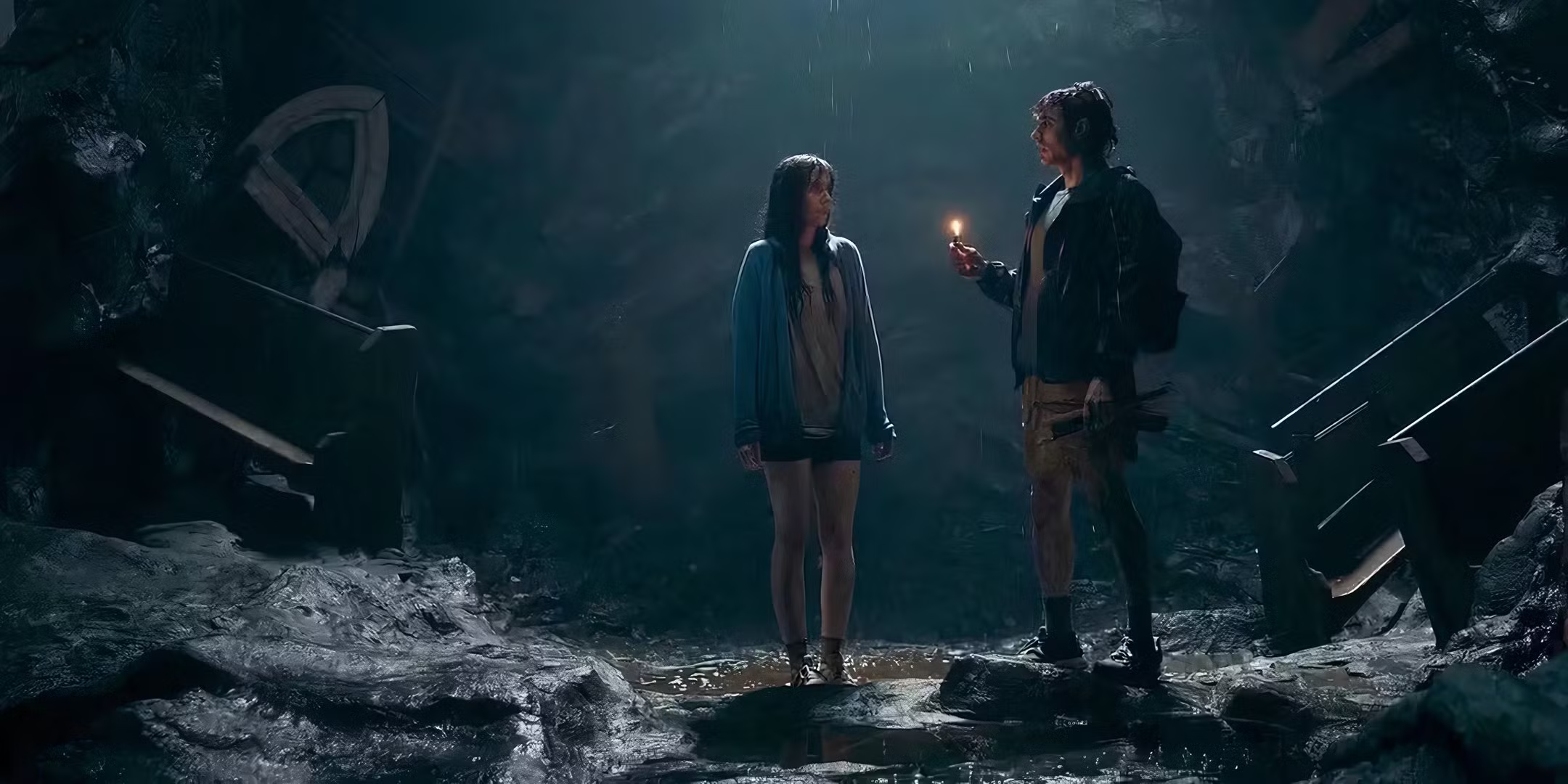
Genesis 2 describes a scene after Adam and Eve have been created, that “Therefore a man leaves his father and his mother and clings to his wife, and they become one flesh.” This is the type of imagery—describing two people in the throes of love—that gets a deranged and unhinged visualization in director Michael Shanks’ body horror film, “Together.”
Married couple Dave Franco and Alison Brie (who also serve as producers on the film) star as Tim and Millie, a couple who have been together for so long that it can be hard for each other to tell where one of them begins and the other ends. That steadiness may sound cute, and there’s a certain comfort in that consistency, but Millie and Tim both worry that their passion has curdled into a complacency; to paraphrase a line Millie says to Tim, do the two love each other or are they just used to each other?
Tim and Millie leave their city life for the countryside as she got a new job as a teacher. The couple explores the woods, only to discover a cave filled with mysterious church bells, pews embedded in the rocky walls, and a well that seems to be exhaling. Parched and fatigued, Tim drinks the water. Inexplicable and horrific events befall the couple after, with the two noticing that the longer they spend in each other’s proximity, their bodies attempt to fuse into each other. To go back to the well of Genesis: “bone of my bone and flesh of my flesh” takes on new meaning here.
For Shanks, the film was a way to take on body horror that was more realistically brutal. “I love 80s body horror, but I didn’t want to do the sort of kitsch visual style where I was recreating a kind of glossy, often gooey sort of aesthetic,” he shared. For Brie and Franco, working on the film was a way to push themselves to their physical and mental limits. “I feel like people need to kind of pull us back in certain ways. There’s something about just being in front of the camera where we want to just give everything we can to make it look as realistic as possible,” Franco said. “I do feel like the longer that we both work in this industry, the more we crave the excitement of trying new things and facing our fears. If [a job] scares me, it likely is something I should try,” Brie concurred.
Over Zoom, RogerEbert.com spoke with Brie and Franco–who were so in sync they began to finish each other’s sentences–and then separately with Shanks. Per the film’s MO around fusing, this piece combines their interviews into one, fluid conversation. The trio spoke about creating the crepitating look of the body horror, how to maintain individualism while being a public couple, and the fascination around telling stories about what it means to age gracefully.
This conversation has been edited and condensed for clarity.
This interview contains spoilers for “Together.”
Michael, one of the challenges of setting a horror film in the modern day is how to incorporate the reality of technology. Our phones can demystify what’s terrifying, but in “Together,” you make exif data and geotags a part of the plot. What are the fun challenges of having to use the accoutrements of tech from a storytelling perspective?
MS: There was no question about setting this film in the modern era because it’s very much based on my relationship with my partner. Despite being slightly curmudgeonly, I do live in the present day (laughs). There is such a cliché in horror films where characters tend to lose their phones early on. That is always kind of slightly frustrating as a viewer and as a filmmaker to deal with, and it can feel lazy.
This happens in “Together,” but I tried to make that development something that informed the characters’ arcs. When Tim and Millie fall into the cave and Tim drops his phone in the water, there’s that joke about the only thing Tim is worried about is losing his music demos. That is genuinely what I think I would say because I do have a whole album of unreleased music that is only on my phone, and I don’t know how to get it onto my computer.
There’s also that scene where Tim is on Facebook and looks at the page of someone who has gone missing and is probably dead. I remember thinking how strange and macabre that must be. That was something I did, though; there was this horrible accident near where I lived. I kind of looked up the names of one of the victims who had died in this crash, and I found them on Facebook. It was a public account, and they had two mutual friends with me. Thatfreaked me out. I was in my early twenties when this happened, but suddenly I could use this modern digital space like a stalker. I was able to look at the final posts of this guy who lived just a suburb over from me, who was now no more. It was strange.
It’s not remotely the same scale of tragedy, but it makes me think of how sometimes I’ll find out that two people aren’t dating anymore because I notice they’ve removed photos of them as a couple, and they’re not following the other person anymore.
MS: This technology–particularly social media–is such a part of our lives that to portray modern life accurately means they have to be featured in some way. There is something uncinematic about filming laptop screens; we don’t have a lot in our film, but I’d like to think it was crucially deployed. In horror films in the past, there would be classic horror scenes where the characters would go to the library and look at the microfiche and Zoom in on all these old newspapers.We’ve replaced that process with what you were saying, with looking at the geotags for everything. I wanted to make it believable and relatable because that rabbit hole that Dave went down was the sort of weird thing I would do late at night.
In another interview, you spoke about the Heaven’s Gate movement as a point of reference for this cult community we see. How much backstory of this cult did you build out?
MS: I wrote this film about 7 years ago, and when I think back on all the drafts of the film, it’s very similar to where it began. One of the things that wasn’t in the first draft, though, was the cult element. There was this ancient kind of force, the cave, and the water, but there wasn’t an additional element of this community that had encountered this water and tried to harness it. Once I kind of had that idea, it elevated the horror elements of the film.
I was conscious of not wanting to have that scene in the third act where a character sits down and explains everything. So I worked out a mythology for the cult and for what this kind of force might be, but I wanted to reveal it to the audience in the same way the characters receive the information in a film, where you paint enough of the contours and you can let your brain fill in the middle.
What’s funny is that I saw “Bring Her Back” later during its run because I was flying with the film and going with it to festivals. I know Danny and Michael Philippou a bit and love their work. When I got to see the film, I was like, “Man, this is such a funny parallel thatthese two Australian horror movies released months apart both have this cult element that they don’t fully explain, yet it is explicated to the audience via 90s VHS tapes. I’m delighted by it.
Cults in Australia are so considerate in that they’re gifting their potential followers video tutorials. Not to get all Cinematic Universe-y, but if there were ever to be a sort of cinematic universe with NEON films, you have your secret society, S.H.I.E.L.D., right there with this cult.
MS: (Laughs) [In Nick Fury voice] I would like you to join the “Together” initiative.
Exactly. More on the body horror elements, there are lots of ways one could have crafted visuals around two couples fusing, but there’s something so crunchy and visceral about your depiction. Can you speak to how you built out that visual language, particularly with folks like prosthetics designer Larry Van Duynhoven and special effects supervisor Arlo Markantonatos?
MS: One of the things I do when I’m writing is I draw quite a lot. I’m not necessarily a great illustrator, but if I have an idea for a scene, I might draw a picture of it first, which helps unlock something in me to be able to write more. Then I storyboard very fastidiously. The direction I have for the body transformation to Larry and his department–and also tothe visual effects department led by Genevieve Camilleri, who did some of our more intense transformation moments where practical effects just weren’t going to be viable–was that I want it to feel like there’s friction.
I love 80s body horror, but I didn’t want to do the sort of kitsch visual style where I was recreating a kind of glossy, often gooey sort of aesthetic. I was thinking more of what it would look like in the modern horror aesthetic. For example, I love “The Substance,” but it’s also very, very much celebrating that slippery and goopy style. I want the body horror in “Together” to feel dry and crackly.
“Crackly” is the perfect descriptor there, especially amplified through the sonics of that scene.
MS: Oh yeah, shout out to the supervising sound editor, Paul Pirola, for that. At that moment when they’re fusing into each other, I think back to this memory from being a kid, and I had this one uncle who, every time he shook my hand, he would shake it so hard. He was a famous rugby coach and was a lovely guy, but every time he squeezed my hand, I would dread it (laughs). I could feel the tendons getting crumpled. So I told the department heads, “I want this shot to feel like an uncle who is shaking your hand too hard.”
The other direction I gave for that moment, I think it was written in the script, was that I want Alison’s and Dave’s arms to feel like the closed umbrella that was being unhappily snapped. Those were some things that were at the top of my mind; it’s more of a feeling than just expressing a visual, but everyone did an amazing job interpreting those images onto the screen.
I’m curious: that picture of the malformed dog that one of Millie’s students drew, is that something you drew?
MS: No, I didn’t; I tried to draw, but I couldn’t get anything close to it. Then somebody in the art department was like, “I know a guy who specializes in drawing kids’ drawings for films.” This guy has done it in a bunch of movies and can draw something that looks clear and you can understand what it is, but also looks like there’s this amateur kind of quality, which is an amazingly specific skill. He drew forty versions of that picture, and they were all amazing, so I just had to choose which fit best. I have it on my wall back at home, just next to the Dave Franco bust that was built for the film (laughs).
Alison and Dave, I remember an interview you two did for “The Rental,” and how you both did Molly “for research purposes,” particularly for you, Alison, since your character uses it. You both aren’t afraid to commit yourself to your roles, and in “Together,” y’all have honest bruises and scars to prove it. As actors, how do you decide “I’ll try this crazy setpiece myself and throw myself into this” versus when do you go to your stunt doubles and say “Bray, Heather, and Monique, actually you do this instead.”
DF: I think the only stunts that we didn’t do ourselves in “Together” is when we fall into the cave …
AB: There’s also a big fall in the driveway.
DF: No, I fell.
AB: Yeah, but there’s that moment where Bray falls back really hard.
DF: They didn’t use that take! I’m not giving that to him (laughs).
AB: (laughs) Anyways, I have a contortionist double as well.
DF: Everything else was us. As you can imagine, we got very injured on this film, and every day we were walking away with several bruises. I think about the shower scene where I am fully nude, my character’s unconscious, and I’m throwing my limp body against these porcelain walls, and I can’t brace myself. That’s me just smacking my face into the wall, which hurts.
AB: To speak more to what you’re asking about, I think how I approach a lot of this stunt work in particular is with a sense of adventure. I do feel like the longer that we both work in this industry, the more we crave the excitement of trying new things and facing our fears. I sort of use that as a prognosticator of which job I should take. If it scares me, it likely is something I should try because maybe it’s something I haven’t done before. This script was certainly all that.
DF: When the cameras are rolling, I feel like people need to kind of pull us back in certain ways. There’s something about just being in front of the camera where we want to just give everything we can to make it look as realistic as possible. Sometimes there were moments where a stunt coordinator is like, “We’re not allowing you to do that.”

Well, to that intensity, that sequence where the two of you are dragging yourselves across the hallway is a standout. It almost felt like it was a pregnancy scene in a way because of how you two were talking to each other. “You have to keep pushing! You’re so strong!” was being tossed around, but it’s about trying to get rid of something instead of giving birth to something.
DF: That’s interesting …
AB: We hadn’t looked at it in that way before. That was a really high-intensity scene, and there was this fun shot that I think Shanks had not planned in advance. At one point, he put the camera on the ground on this little swivel rig so that they could get both of our coverage through the whole scene in one take. It was the most exhilarating thing.
We were both going full force even when we were off camera in that scene for each other, but it was fun to play it straight through that feeling of the tension with one another. We had some discussions about whether we could use that oner footage for the whole scene, but you want to see more dynamics in terms of what’s happening to us physically. But some of that footage is incorporated, which makes the scene really dynamic.
DF: That was the only scene that we shot over multiple days. I remember after take one, day one, there’s footage of me just giving everything to this take and looking up at the camera and saying, “This is gonna be a long fucking scene.” It’s one of our favorites, though. We were just so excited about the footage that we were getting. It just really felt like we were hopefully creating something that people have never seen on screen before. That excitement fueled us through any of the pain that we were feeling.
I know the final version uses a mix of your stunt work, Alison, and also of your body doubles’ work, but I heard elsewhere that there is a take of you, Alison, doing that whole contortionist scene by yourself. Are we getting that on a Criterion release or …
AB: We would like for you to.
DF: So obviously Alison’s face was CGI’d onto the contortionist but …
AB: I did both; I can’t do a back bend like how you see in the movie, but I tried to mimic the physicality of that scene for one take. Then there was an opposite take where I just remained still and sat in the hall, and Shanks said, “Just your face, give us the whole scene.” So for two and a half minutes, I was just making facial reactions as if my body was contorting. That footage is like its own avant-garde horror movie where I’m just sitting there screaming in pain.

That’s commitment, truly, just to flash forward to the end of the film for a bit, I have to ask: is “2 Become 1” the wildest song you both have made out to or danced to together? Just curious where that might fall on the rankings …
DF: (laughs) I feel like there’s been stranger ones …
AB: Here’s what I’ll tell you: our wedding was really small; we just had a small ceremony with just our family. But then we had a reception with sixty friends or so, and we didn’t want to do any of the traditional stuff. We didn’t plan a first dance, but inevitably, we both found ourselves on the dance floor at the same time.
If you’re at a wedding, when the bride and groom are on the dance floor at the same time, everyone clears the floor. All of a sudden, we found ourselves dancing to Lil Wayne. We were doing this beautiful slow dance, everyone left the dance floor, then, and we were both like, “I guess our first dance as a couple is to Lil Wayne.” Was it “6 Foot, 7 Foot?” or “A Milli”?
DF: Maybe … in our wedding vows, my vow to Alison was that I would dance with her no matter where we were. She takes advantage of this when we’re in public, if we’re at the movie theater, or a grocery store, or restaurant … if there’s bad music anywhere …
AB: I’ll give him a look and he’ll just be like “Oh no ….” but he always does it.
That’s commitment, truly. To lightly touch on spoilers, have you two speculated how Millie’s parents respond when they open the door and are greeted by your hybrid?
AB: (Laughs) I think Shanks, Dave, and I all agree that this movie could not go on a second longer because the longer the movie goes on, it opens a whole new can of worms. I’dl ike to imagine there’s just a pleasant brunch.
DF: She likes to believe that the parents immediately accept this new person in front of them.
AB: Dave’s not sure it goes that well.
DF: I just think the movie takes a hard right turn, and you just explore completely new territory.
AB: I think now, actually, that we’re serving the parents some water and recruiting new members.

The possibilities are endless for a sequel. I was talking with my friend, Claira, and we ruminated on how so much of the promotion of this movie has centered around you two being a couple. From our discussion, I wanted to ask: How do you two maintain your autonomy and individuality when you’re also a public-facing about your relationship?
AB: I feel like it was nice that we’ve ramped up together to this movie. We acted together in “The Disaster Artist” and “The Little Hours,” and then Dave directed me in a couple of projects, of course. We’re always really conscious about going and working on other projects separately. We love working together, and we love maintaining independence and doing projects on our own as well.
I’ve honestly been thinking a lot about this on this press tour that I’m so glad that we’re doing something like “Together” now, thirteen years into our relationship, we have established ourselves separately. We have our careers within this industry, and I think it would scare me if this were year one and we were parading around talking about how wonderful our relationship is.
DF: It’s a good question. As open as we’ve been about our relationship on this press tour or in past press tours, we still do have boundaries. We’re very private people. I’m not even on social media, and I feel like we have been pretty good about …
AB: Keeping our home a safe place. You can’t give it all away. You have to reserve some things for yourself, and we do try to do that. It might not seem like it on this press tour, but it’s true.
DF: There are a lot of people who are still surprised to find out that we’re together, and that’s not necessarily a bad thing.
Michael, I screened your short film, “Rebooted,” and a throughline across a project like that and “Together” is that you seem to be ruminating a lot on what it means to age gracefully. Millie and Tim are together, and are worried they’re just used to each other instead of being in love … what brings you back to the well of this theme?
This is kind of an embarrassing thing to say, but I had comparative success in my career when I was very young. I made a little short film in my final weeks of high school that won this film festival and got me a job professionally working as a filmmaker as a 17-year-old. I told myself then, “Oh, maybe I’m quite good at this. Maybe this is the beginning of how I’m going to become a filmmaker or a musician.” I had these years where every project I would work on would get bigger, better, and more well-received, but then at a certain point, I found it hard to graduate to the higher level.
I’m still only 34, but for about 8 years, that was a chunk of my life where I was like, “Oh no, have I already peaked? I feel like I have and now I’ve lost it? Is it now embarrassing for me to be somebody entering his thirties, now going to his mid-thirties, who is still publicly saying ‘I’m going to be a filmmaker.’” Those questions formed the character of Tim; he’s worried that he’s missed the boat to fulfill his artistic ambitions.
The same sentiment courses through “Rebooted.” At that point, I had already made short films, and I wanted to make a feature film because at that point, I had also made a television series in Australia, and I wanted the next thing I did to be bigger. I loved the story “Rebooted” and its concept, and at the same time, there was a part of me that was like, “Oh, I’m going backwards. I’m making a short film.” I was feeling aged and irrelevant. So I do feel myself drawn to characters like that who are full of regret. I think it’s cathartic that throughout these stories of mine, these characters sort of typically find, in their way, sort of happiness. It’s a happiness that hopefully I’ll find one day.
Source link

